Several species of bees love my trumpet vine as much as hummingbirds do, which sets the stage for conflict.
Each of the three series of photos below was taken a couple of days ago at the trumpet vine in my side yard. In most of the photos the hummer or the bee is soft (in a couple of photos both of them are soft) because of a lack of depth of field.
But that doesn’t mean that the bird and the bee weren’t close to each other. With my photo gear, at the settings I was using and at the distance I was from the hummer (17′), I only have about 1/4″ of depth within which everything is truly sharp. So in these series, if the hummer is sharp and the bee is fairly soft, or vice versa, the two of them were still quite close to each other.
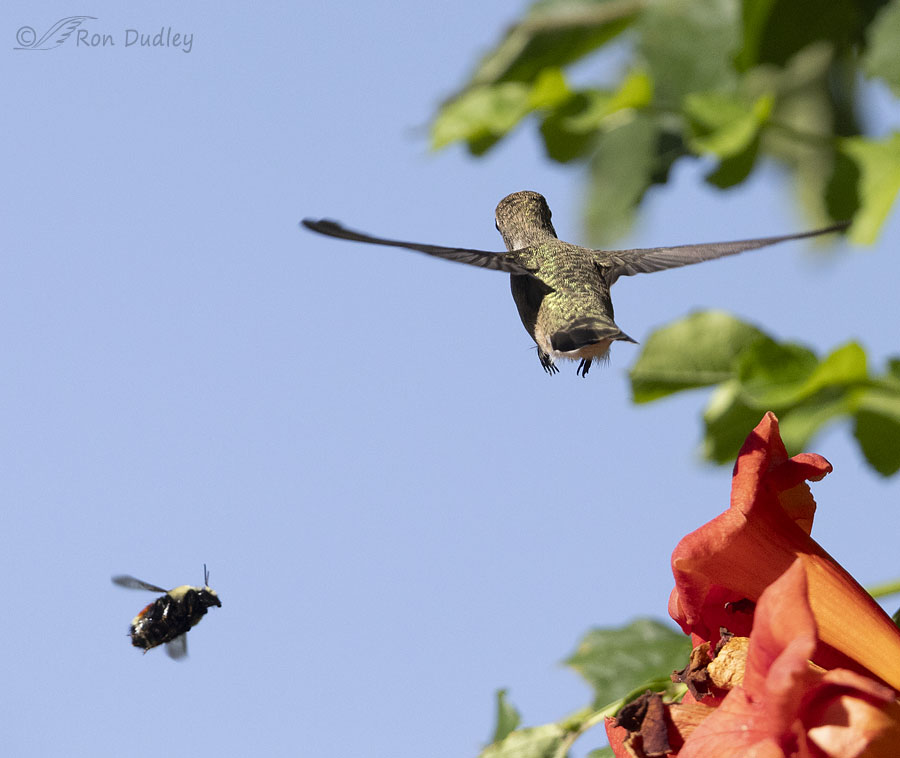
I never knew when a bee was going to appear on the scene and neither did the female hummer but she sure didn’t like it when they showed up. When they did she always stopped feeding on the flowers and watched the bee intently and sometimes she just skedaddled.
Most of them were honeybees but this one was a bumblebee and it sure got her attention.
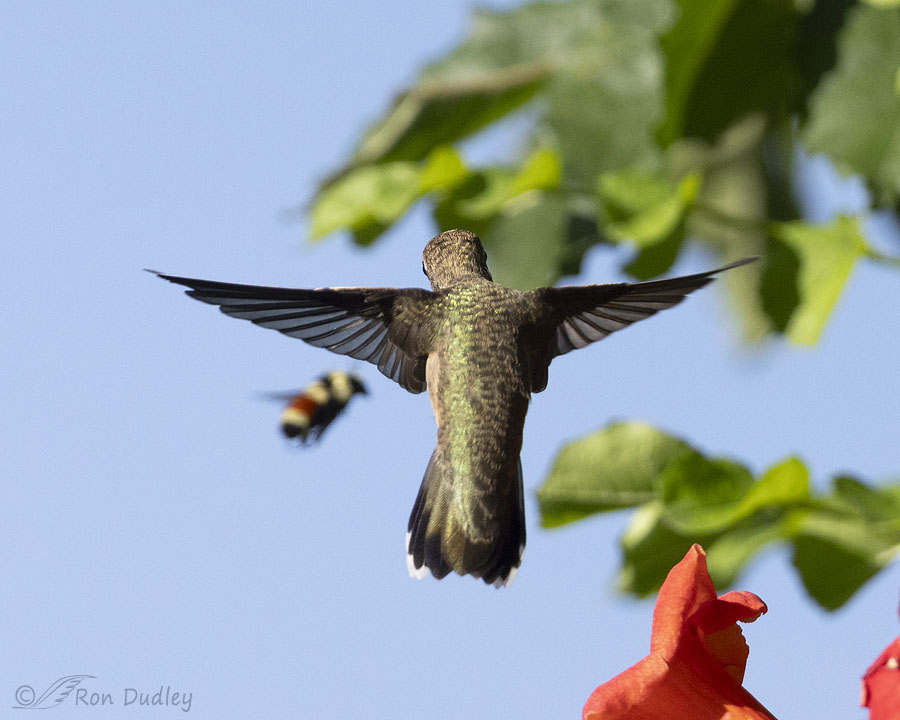
She backed off a little, kept her eye on it and waited until it was gone before going back to feeding on the flowers.
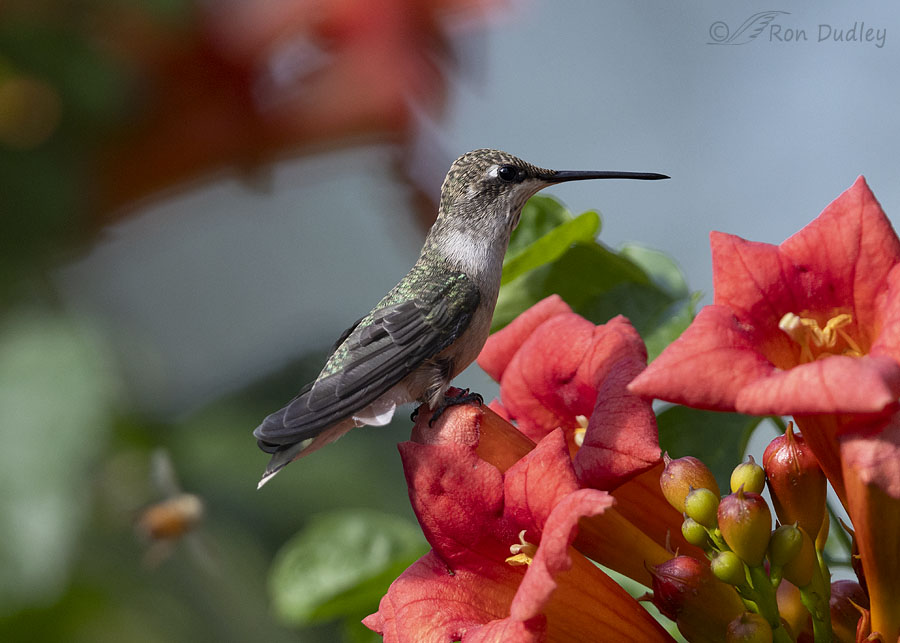
This may or may not be the same hummer but in this case the bee near her tail had sneaked up on her. At this point she didn’t even know it was there.
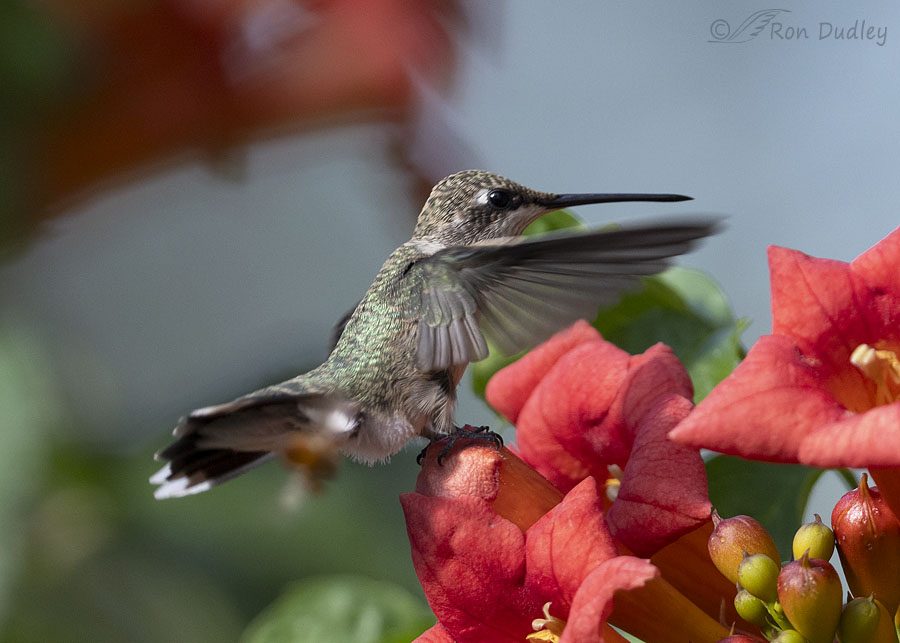
But when the bee almost looked like it flew up her butt it got her attention.
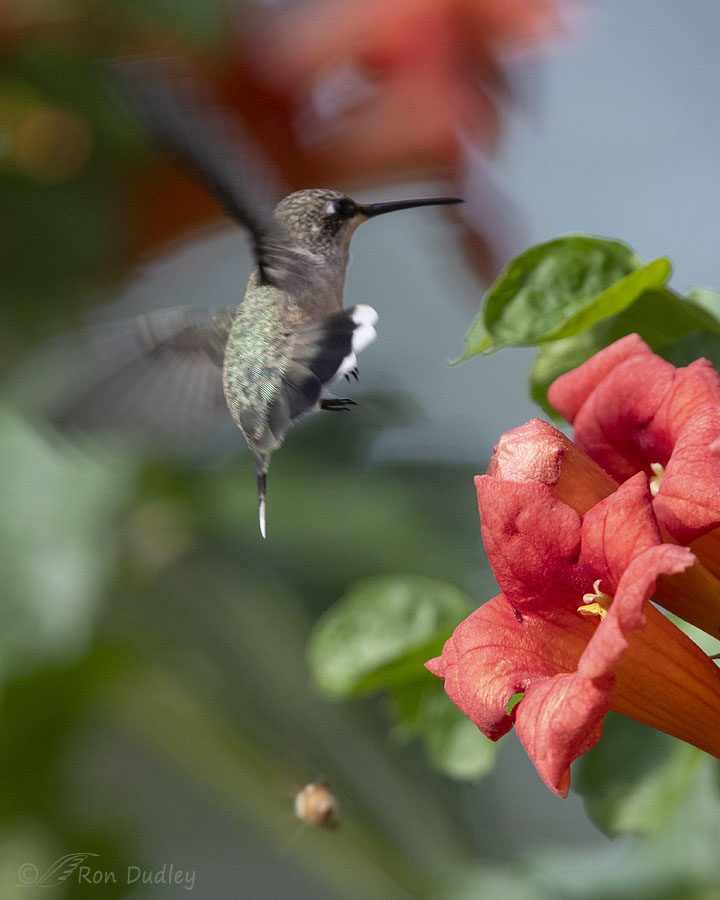
She reacted by backing off as the bee disappeared out of frame at bottom.
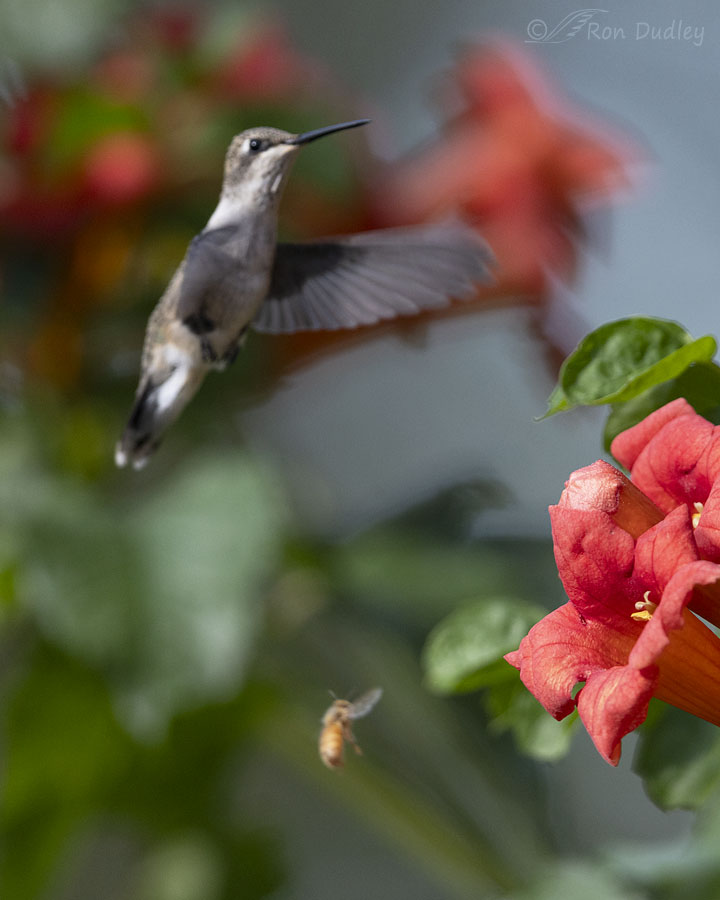
But six photos in the burst later the bee was back and…
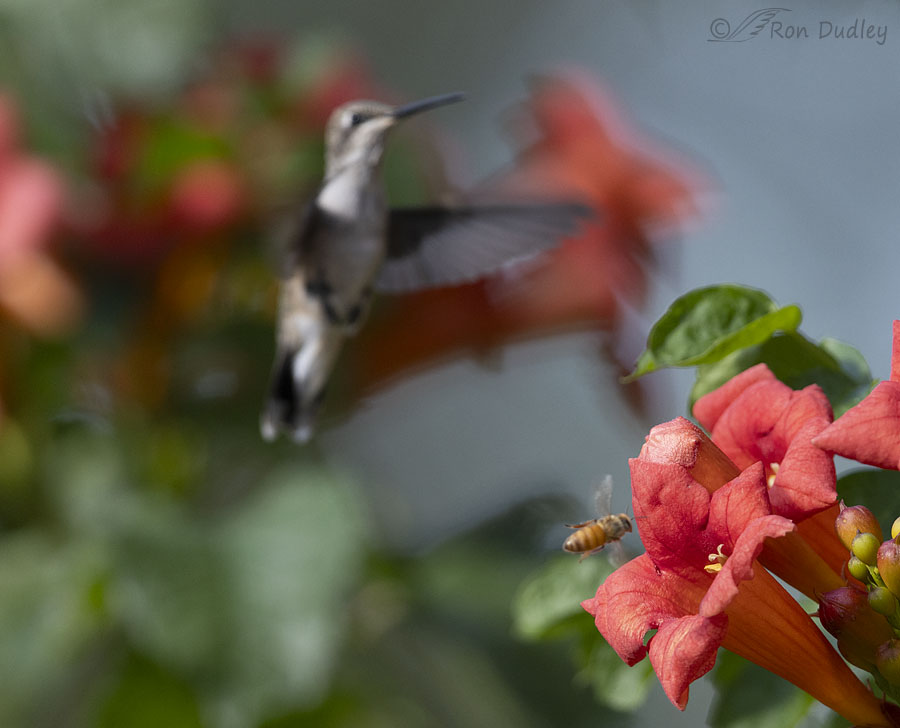
went to a flower right next to the flower she’d originally been perched on. So after this shot was taken the hummer moved on to a different flower cluster much further away.
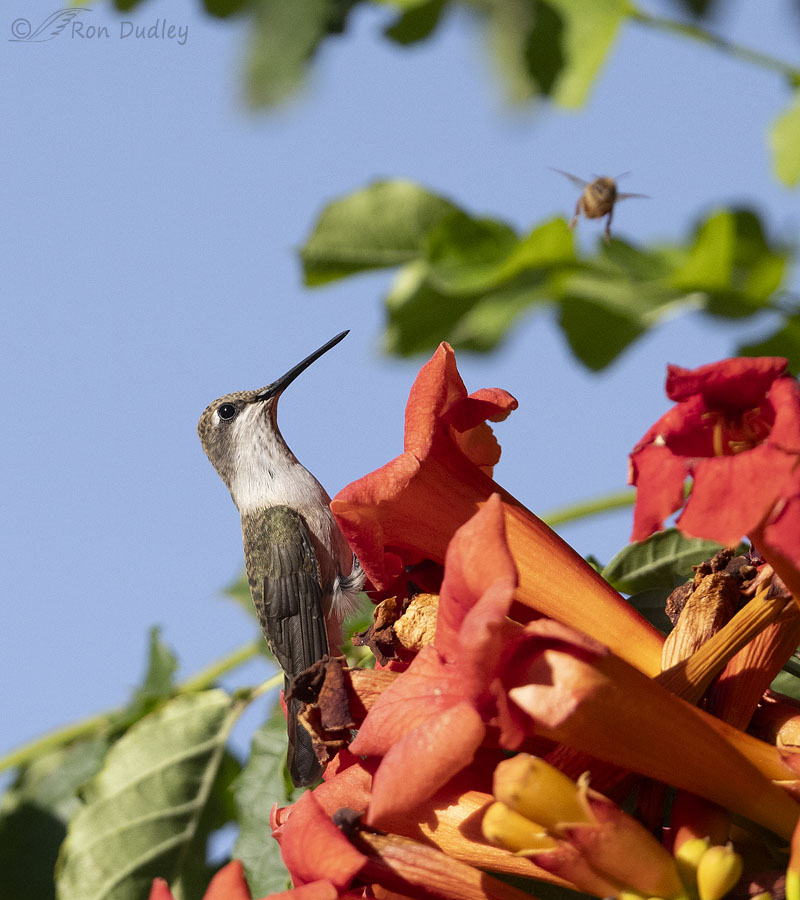
Again, I don’t know if this is the same hummer as before but she had a similar reaction when this bee showed up.
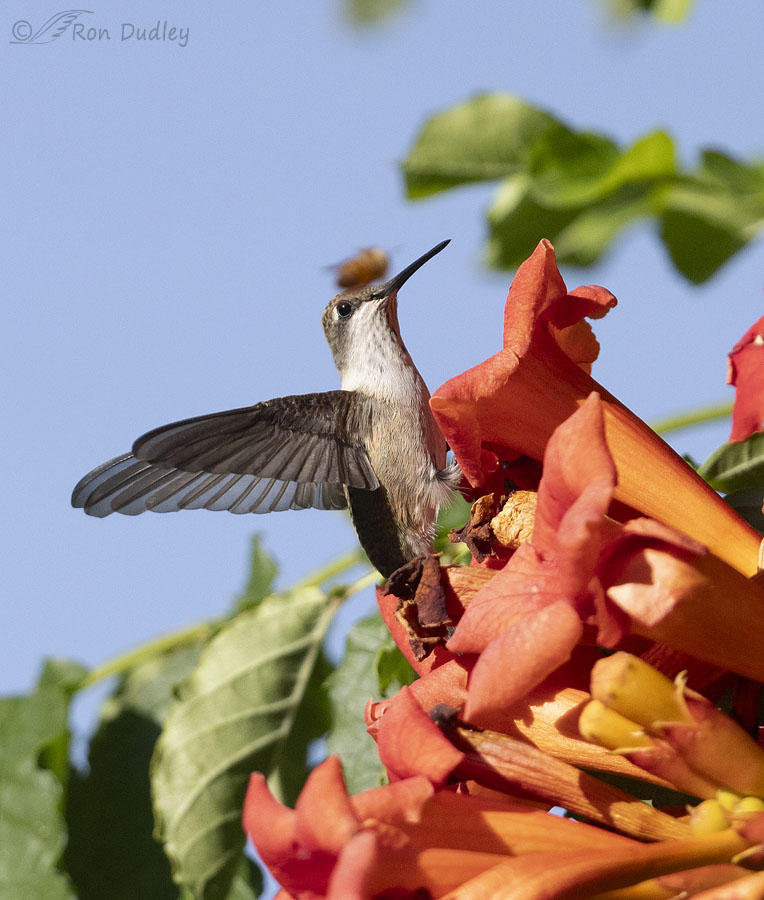
Way too close for comfort but…
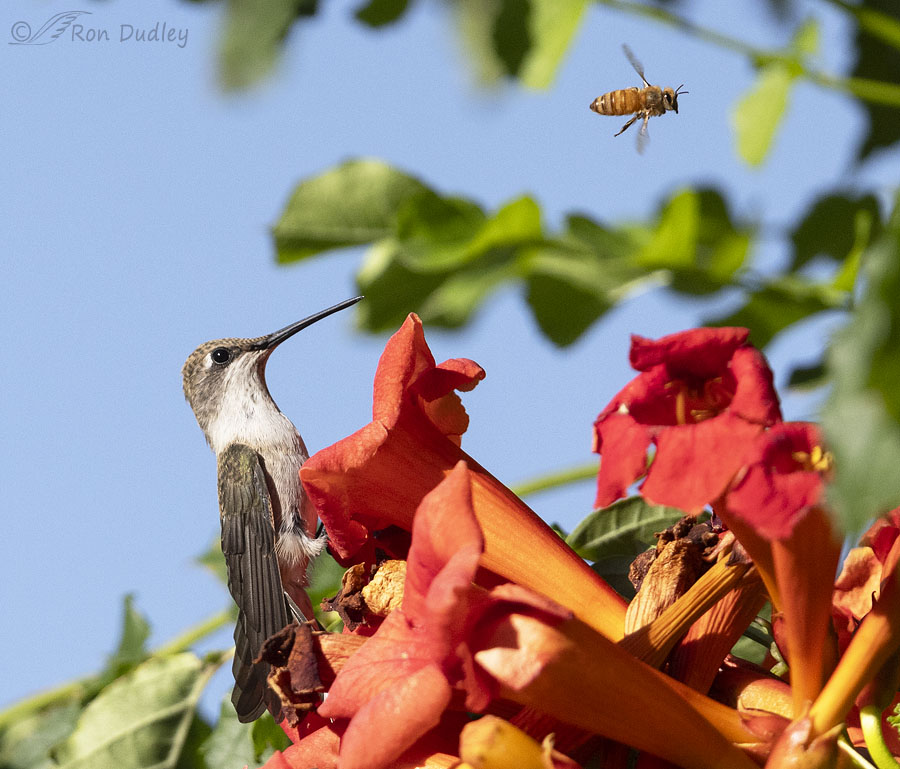
she stood her ground as the bee began to move on. Of all of the hummer/bee photos I got that morning, this is the only one where both bird and insect were truly sharp.
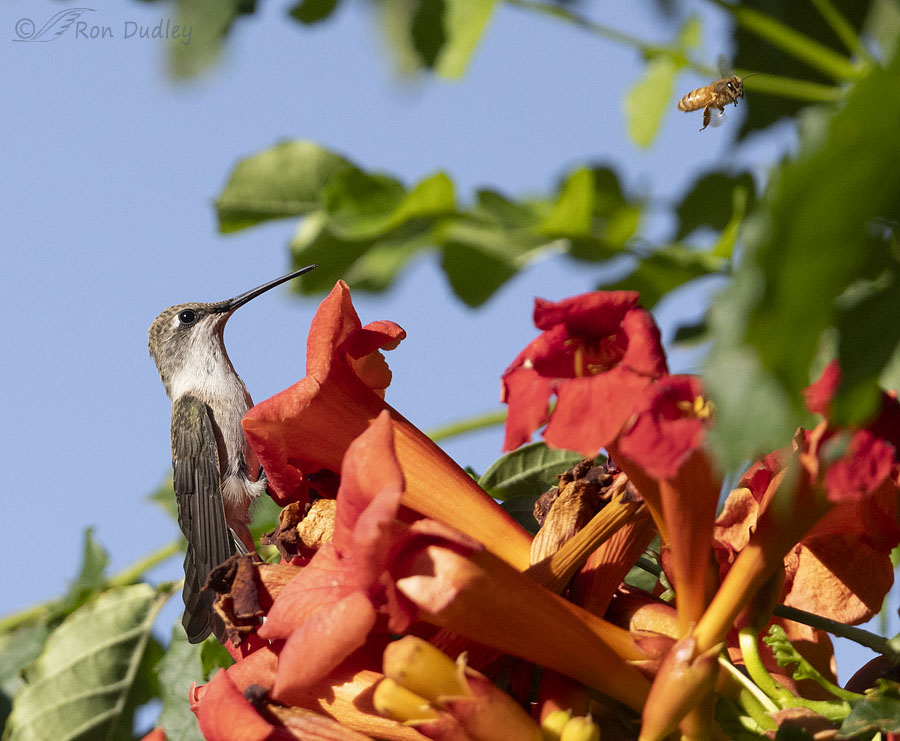
This is the last shot I got with the bee still in the frame. And yes, she’s still watching it intently.
I wondered if bees actually sting hummingbirds occasionally and found this:
“Hummingbirds do not eat bees or wasps. Even though hummingbirds eat insects as part of their diet, hummingbirds do not consider bees or wasps to be a food source. One reason is being stung can be fatal.
The venom from the sting or stings of either bees or wasps can overwhelm the small body system of the hummingbird resulting in death. For example, the Ruby-Throated Hummingbird weighs approximately 3 grams (about 1 American penny) and only measures 3 – 3.5 inches (half of a dollar bill). Too small to fight off the venom injected by the stinger.”
If I were a hummingbird I’d be careful too. I’m not and I’m still careful.
Ron


Really interesting shots, Ron! I especially like the way she’s using her tail in the 3rd and 4th shot.
Rain knocked a lot of my citrus blooms off the trees, so I didn’t get much of a chance to observe, but I’ll be sure to get out next time!
Thanks, Marty. Your comment brought back memories of the smell of orange blossoms when we lived in SOCAL when I was a kid.
You’ll have to come and visit during the he next blossom phase. 😃
How fascinating. And more than a little scary. I blow up in a spectacular fashion if a bee gets me so I totally understand the hummers caution. I do wonder how they know though – it is not as if they will get a second chance.
“it is not as if they will get a second chance”
EC, that’s one of the reasons I think it’s probably an instinctive fear.
Very interesting. Sadly I don’t have many honey bees. The local hives failed. I do have small wasps and bumble bees along with a few hover flies and bee flies. Unfortunately I have a bumper year of yellow jackets.
April, I know of no local hives but honeybees seem pretty numerous in my yard this year. And last year the wasps had nests on my shed and deck but I haven’t seen any wasp nests this year and almost no yellow jackets. Hate those damn yellow jackets.
Great series, especially having both species in the same shot. Here is another fascinating connection between hummers and wasps. Hummingbirds have no olfactory lobe so no sense of smell – or so we thought. A study published last year found Broad-tailed Hummingbirds can detect vespid wasps (like yellow-jackets, etc. ) and some ants with a strong formic acid sting. Both are a danger to the bird. As the hummer approaches a flower, mostly tubular flowers, it sniffs at the entrance. If it detects the presence of one of those insects by smell, it does not enter the flower but leaves for another. The insects may not actually be present but their scent may linger. Both insects will have entered the flower for the nectar. So if the bird smells one of them it means that there may be danger inside or that that flower has no nectar. Either way, it’a best to avoid that flower. By the time the scent of the insect is gone the flower will have made more nectar. Our world is endlessly fascinating
Fascinating, Dan. The question that comes to my mind is – If hummers have no olfactory lobe at all, how are they detecting the ‘odor’ of the wasps by smell?
There is a region of the brain that provides olfaction but not a discreet lobe as found in many vertebrates. It was once thought that only a very few birds had any sense of smell. We now know that many birds can smell but often in a very limited way. For example male starlings bring particular plants to weave into their nests. They find these by smell and these plants have chemicals that act to deter insects. As a result, starling nests often have fewer nest parasites than many of our native cavity-nesters
OK, that makes sense – the “not a discreet lobe” part. Thanks, Dan.
Buzzed by the bees. Always a good time to move to another blossom or another location. I have never been afraid of bees, but one time out birding I ran into some folks on horseback who warned me to not go down the trail I was going because there was a huge swarm of bees there so I did back off.
Everett. as a kid on the MT farm I was riding my bike fast down a hill on a dirt/gravel road when a bee bit me on the ankle. I crashed and burned, so for the next week or so I was a road-rash mess.
Laughing, but know that hurt. We can only handle that kind of pain back when we were kids.
Another fabulous science lesson! The whole myth of the “Peaceable Animal Kingdom” takes another battering😮 The Hummer’s tiny feet are too precious – on a par with the Kingfisher’s. Thank you for documenting this, and telling us about it!
“on a par with the Kingfisher’s”
Accurate observation, Carolyn. Thank you.
I can’t fathom how you got both in focus in the one shot, while also capturing the story. Great series.
BTW – I didn’t see your settings — I imagine you had to use a really fast shutter speed and high ISO.
Kent, sometimes I get lazy and don’t include image techs, especially for documentary photos like these.
Techs for most of these shots were in the range of 1/000-1/8000, f/.5.6, ISO 1000-1600, Canon R5, Canon EF500mm f/4L IS II USM + 1.4 tc.
Thanks — I was just wondering as its so hard to get share shots with two separate moving subjects, fast wingbeats, and darker and lighter colors.
These photos and action shots beat any “Mission Impossible” movie!
I am grateful for your skills.
Take Care,
Kaye
Much appreciated, Kaye.
Wow!! Thank you, Ron!!
You’re very welcome, Mary.
Fun and colorful capture Ron! The 9th shot looks like the bee is trying to land on the hummer’s head. Having two small subjects together gives such perspective on the size of the hummers.
Thank you, Kathleen.
Poor hummer ! At my house, it’s wasps that hummers have to actively avoid while trying to feed from nectar feeders, and it’s a real dance for them to do it, as there are very few natural sources of nectar in my yard. Until your post today, I never thought very hard as to just how lethal a sting would be to such a tiny body/high metabolism……
“tiny body/high metabolism” – that’s exactly the combination that would make bee stings lethal for them.
Thank you so much for these documentary photos that still manage to be beautiful. And btw my amaranth are budding, even after a late planting and a hail storm that almost flattened them. Yay!
Cheryl, my amaranth was really hammered by hail on June 3rd. It shocked them and they never fully recovered. Last year some of my amaranth was nearly 13′ tall. This year the tallest is less than 8′ and I don’t think they’ll get much taller.
Mine are REALLY slow – about a foot tall at this point – obviously don’t like the spot/climate…….we shall see!
They like lots of sun…
This is fascinating. First off, great photos in of themselves, but also documenting this encounter. I have a similar trumpet bush outside my desk window and while I have watched hummers and bees come around to enjoy the bush, I have never observed this sort of encounter before.
I wonder, just how do the hummers know that the bees can sting and that it could be fatal? Instinct? Perhaps, at their scale, they can see the stinger?
From my experience, there is no other flying creature that seems to intimidate a hummer. In fact it is usually the other way around. I’m still trying to digest all this. A real paradigm shift.
Thanks professor!
“Instinct?”
That would be my guess, Michael. Even very young hummers know to avoid bees.
And I’m tickled to know you enjoyed today’s post as much as you did.
Sure does give perspective on just how small hummers are! “Bee up her butt” literally rather than a “bee in your bonet” 😉 Fun series, Ron.
Thanks, Judy. I really enjoyed Mike’s photos of the Two Medecine/Marias area this morning. My old back yard.